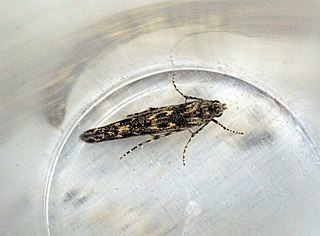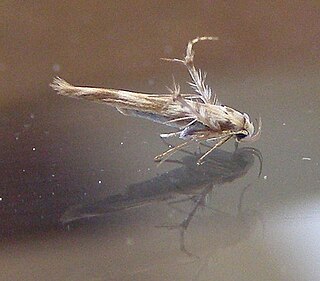
Batrachedra is the largest genus in the moth family Batrachedridae, with representatives all over the world. The early stages of most species are unknown. The genus name is derived from the Greek words batrachos, 'frog', and edra, 'seat', referring to the frog-like resting posture of the adult moths. As of 2018 at least some 114 species are known to belong to the genus.
Idiophantis is a genus of moths in the family Gelechiidae.

Palumbina is a genus of moths in the family Gelechiidae.

Calamotropha is a genus of moths of the family Crambidae.

Anatrachyntis is a genus of moths in the family Cosmopterigidae. Some authors include it in Pyroderces.

Labdia is a genus of moths in the family Cosmopterigidae.

Opogona is a genus of the fungus moth family, Tineidae. Therein, it belongs to the subfamily Hieroxestinae. As it includes Opogona omoscopa, the type species of the now-abolished genus Hieroxestis, it is the type genus of its subfamily.

Prays is a genus of moths of the family Praydidae, formerly assigned to Plutellidae or Yponomeutidae.

Stathmopoda is a genus of moths. It has variously been placed in its own family, Stathmopodidae, or in subfamily Stathmopodinae in the family Oecophoridae. Note that the phylogeny and systematics of gelechoid moths are still not fully resolved.
Thiallela is a genus of snout moths. It was described by Francis Walker in 1863.

Glyphipterix is a genus of sedge moths. It was described by Jacob Hübner in 1825.
Glyphipterix argyromis is a species of sedge moth in the genus Glyphipterix first described by Edward Meyrick in 1907. It was described by Edward Meyrick in 1907. It is found in southern India and Sri Lanka.
Glyphipterix oxycopis is a species of sedge moth in the genus Glyphipterix. It was described by Edward Meyrick in 1918. It is found in Assam in India and in Sri Lanka.
Glyphipterix tetrachrysa is a species of sedge moth in the genus Glyphipterix. It was described by Edward Meyrick in 1907. It is found in Sri Lanka.

Typhonia is a genus of moths of the Psychidae family.
Sapheneutis is a bagworm genus.

Gracillariinae are a subfamily of moths which was described by Henry Tibbats Stainton in 1854.
Acria is a moth genus of the superfamily Gelechioidea. It is placed in the family Depressariidae, which is often – particularly in older treatments – considered a subfamily of Oecophoridae or included in the Elachistidae.
Cryptolechia is a genus of moths in the family Depressariidae.

Calicotis is a genus of moths in the family Stathmopodidae, although it is sometimes included in the family Oecophoridae. In 2024, the genus Pachyrhabda was synonymised with Calicotis.











